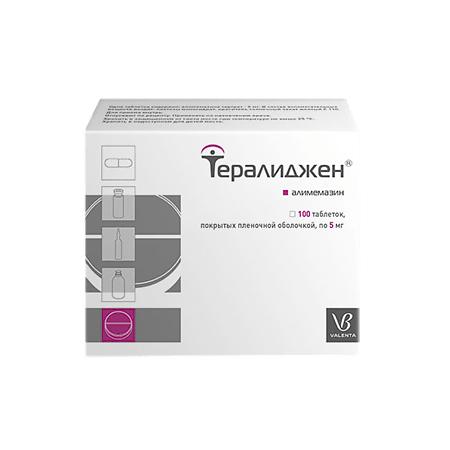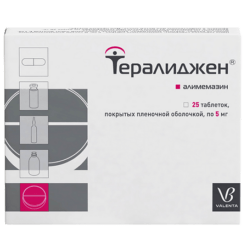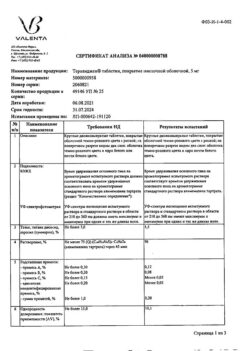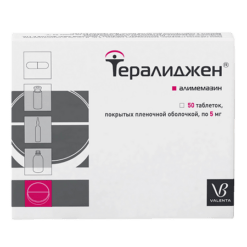No products in the cart.
Theraligen, 5 mg 100 pcs
€63.51 €52.92
EAN: 4602193010529
SKU: 501181
Categories: Medicine, Neurology and Psychiatry, Sedatives and hypnotics
Description
Pharmacotherapeutic group
Anxiolytic medicine. Sedative
ATH Code
R06AD
Pharmacodynamics:
It is a phenothiazine derivative.
Alimazine acts as a mild sedative and anti-anxiety drug has a positive effect on obsessive compulsive disorder and phobia.
It is used in psychosomatic manifestations developing due to neurovegetative disorders vascular traumatic and infectious disorders of the central nervous system. The sedative effect promotes normalization of sleep in patients in this category.
It has antiemetic and anti-cough activity.
Sedative and anxiolytic effects are caused by blockade of adrenoreceptors of reticular formation of the brain stem. Antiemetic and vegetative-stabilizing action is caused by blockade of dopamine D2-receptors of trigger zone of the vomiting center.
Because of its antihistamine activity, alimemazine is used in allergic diseases especially of the respiratory tract and in itching of the skin.
Alimemazine is more active in antihistamine and sedative action than diprazine. The antipruritic action is due to its effect on type 1 histamine receptors.
Pharmacokinetics:
It is rapidly and completely absorbed by all routes of administration. The action of alimazine begins 15-20 minutes after administration and lasts 6-8 hours. Binding with plasma proteins is 20-30%. It is metabolized in the liver. Excreted by the kidneys – 70-80% as a metabolite (sulfoxide).
Indications
Indications
In adults and children over 7 years of age:
As a sedative (calming), anti-anxiety and sleep-improving agent: organic anxiety disorder (r-vo) (mono or combination therapy); in combination therapy: dementia, schizophrenia (with a predominance of neurosis-like disorders), affective disorders, generalized anxiety disorder, obsessive-compulsive disorder, reaction to severe stress and adaptation disorders, dissociative (conversion) disorders, somatoform disorders with severe anxiety or with ineffectiveness of standard therapy, unspecified regulation of the autonomic nervous system (NS), others autonomic personality disorder (NS), anorexia nervosa, emotionally unstable personality disorder (impulsive and borderline types), hysterical personality disorder, anxious personality disorder, persistent personality change after experiencing a catastrophe, hyperkinetic behavior pattern, behavior pattern limited to the family, unsocialized behavior pattern, anxiety, agitation and other symptoms and signs related to the emotional state, other neurotic patterns (neurasthenia, unspecified neurotic disorder), insomnia of inorganic etiology, emotional disorders, the onset of which is specific to childhood (phobic, social, unspecified emotional, other emotional disorders in childhood. As an antiallergic agent: itching, regardless of location and etiology, asthma, hay fever, whooping cough, unspecified allergy.
In children from 3 years of age:
As an antiallergic agent: itching, regardless of location and etiology (itching with photocontact dermatitis and solar urticaria, dermatitis, eczema, urticaria, bites or stings of non-venomous insects or arthropods, chicken pox, measles, Hodgkin’s disease, diabetes mellitus, shingles, itching: anus, vulva, unspecified anogenital) as monotherapy or as part of combination therapy. As a sedative (calming agent): during medicinal preparation for surgery (for the purpose of sedation before surgery).
Pharmacological effect
Pharmacological effect
Pharmacotherapeutic group
Anxiolytic agent. Sedative
ATX code
R06AD
Pharmacodynamics:
It is a phenothiazine derivative.
Alimemazine acts as a mild sedative and anti-anxiety agent and has a positive effect on senesthopathy of obsession and phobia.
It is used for psychosomatic manifestations developing as a result of neurovegetative disorders, vascular traumatic and infectious dysfunctions of the central nervous system. The sedative effect helps normalize sleep in patients in this category.
Has antiemetic and antitussive activity.
The sedative and anxiolytic effect is due to the blockade of adrenergic receptors in the reticular formation of the brain stem. The antiemetic and vegetative-stabilizing effect is due to the blockade of dopamine D2 receptors in the trigger zone of the vomiting center.
Due to its antihistamine activity, alimemazine is used for allergic diseases, especially of the respiratory tract and for skin itching.
Alimemazine is more active in antihistamine and sedative action than diprazine. The antipruritic effect is due to the effect on type 1 histamine receptors.
Pharmacokinetics:
Quickly and completely absorbed by any route of administration. The effect of alimemazine begins 15-20 minutes after administration and lasts 6-8 hours. The binding to plasma proteins is 20-30%. Metabolized in the liver. Excreted by the kidneys – 70-80% in the form of a metabolite (sulfoxide).
Special instructions
Special instructions
During treatment you should not drink alcohol. When taking the drug, you should not engage in activities that require increased concentration and speed of psychomotor reactions.
Active ingredient
Active ingredient
Alimemazine
Composition
Composition
One tablet contains:
active ingredient:
alimemazine tartrate – 5.0 mg;
excipients: lactose monohydrate, microcrystalline cellulose, pregelatinized starch, colloidal silicon dioxide (aerosil), croscarmellose sodium, magnesium stearate.
shell composition: Opadry II 85F34655: partially hydrolyzed polyvinyl alcohol, macrogol-3350, talc, titanium dioxide E 171, carmine red dye E 120, aluminum varnish based on sunset yellow dye E 110, aluminum varnish based on indigo carmine E 132.
Contraindications
Contraindications
Hypersensitivity, lactose intolerance, lactase deficiency, glucose-galactose malabsorption, angle-closure glaucoma, prostatic hyperplasia, severe hepatic and/or renal failure, parkinsonism, myasthenia gravis, Reye’s syndrome, simultaneous use of MAO inhibitors, pregnancy and lactation, children under 3 years of age when used as an antiallergic agent and for sedation before surgery intervention, up to 7 years for other indications.
Side Effects
Side Effects
Side effects are extremely rare and mild. From the nervous system: drowsiness, lethargy, fatigue (occur mainly in the first days of use and rarely require discontinuation of the drug), paradoxical reaction (restlessness, agitation, nightmares, irritability), confusion, extrapyramidal disorders. From the senses: blurred vision, noise or ringing in the ears. From the cardiovascular system: dizziness, decreased blood pressure, tachycardia. Allergic reactions, muscle relaxation. A list of all side effects is presented in the instructions for medical use.
Interaction
Interaction
Enhances the effects of narcotic analgesics, hypnotics, anxiolytic and antipsychotic drugs, as well as drugs for general anesthesia, m-anticholinergics and antihypertensives. When used: with antiepileptic drugs and barbiturates, the threshold for convulsive activity is reduced; with β-blockers, a pronounced decrease in blood pressure and arrhythmia is possible; with MAO inhibitors or phenothiazine derivatives, the risk of arterial hypotension and extrapyramidal disorders increases. A list of all interactions with other drugs is presented in the instructions for medical use.
Shelf life
Shelf life
3 years
Manufacturer
Manufacturer
Valenta Pharm JSC, Russia
Additional information
| Shelf life | 3 years |
|---|---|
| Manufacturer | Valenta Farm, Russia |
| Medication form | pills |
| Brand | Valenta Farm |
Other forms…
Related products
Buy Theraligen, 5 mg 100 pcs with delivery to USA, UK, Europe and over 120 other countries.

















